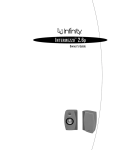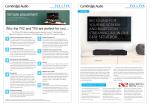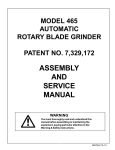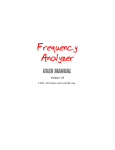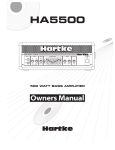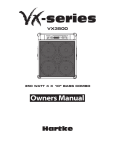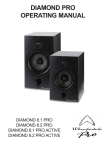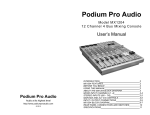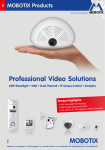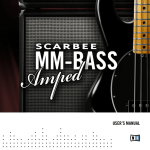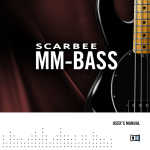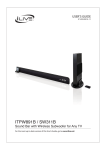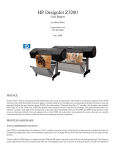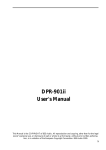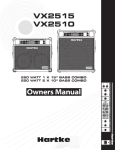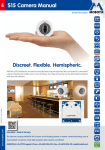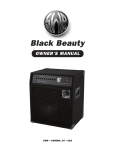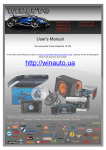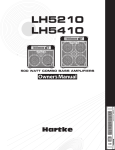Download User Manual V.3.1 © Copyright 2015 Barefaced
Transcript
User Manual V.3.1 © Copyright 2015 Barefaced Limited Introduction and important stuff Congratulations on becoming a Barefaced Gen 3 12XN owner! These cabs are the pinnacle of bass guitar amplification, representing the most efficient way to turn the power and tone coming from your bass and amp into sound with the frequency balance, dynamics, immediacy and dispersion to fill the room in the best possible way. Great tone, at the right time, everywhere! Hyperbole? Maybe, but justified... Before you use your cab, please take the time to digest the following information: 1. Don’t throw the box and protective packaging away until you’re sure you like the cab. If your cab has suffered any damage in transit please contact us immedately! 2. The Super Twin and Big Twin 2 are shipped without their front feet attached. Remove the two bolts in the base of the cab, unwrap the pair of feet from their packaging, and fit carefully. Don’t push too hard with the bolt or you may push the t-nut out from the inside of the cab - let the threads on the bolt engage in the t-nut and then the bolt pull itself into position. Once the foot is snugly in place, tighten the bolt right up so it never comes loose. 2. Use a standard speakon lead or 1/4” lead - we can supply these (£12 / €15 / $18). 3. Daisy-chain if you like - you won’t need many cabs, ours go loud! 4. The Super Midget/Big Baby II/Big Twin 2 have an ‘HF Control’ knob on the back of the cab. Open it up like a tap (anti-clockwise) for increased treble and upper midrange. Experiment and listen to how it changes the tone. Set it however you like. 5. Your cab has a high power 12” driver (or two) which takes time to loosen up. It will get deeper, fatter, smoother and cleaner sounding after some loud use. 6. Set your EQ flat on your bass and amp. Start fresh! If you have two pickups, use the pan or dual volumes for tweaking before you go to the EQ. Try not to stand right next to your cab. Turn it up loud! Turn it down a bit if your band complains... 7. When you’ve decided you’re keeping the cab, tell the world (and us) how much you like it. Tell us where you find out about bass gear so we can preach to the unconverted. If it isn’t nailing your tone(s), email us for help! (If any residue is left behind after removing the QC label, this can be safely removed with white spirit). You may think plenty of bassists know about Barefaced but we can assure you that only a tiny fraction of them have even heard our name, let alone realise that we are producing arguably the best bass cabs ever made, regardless of your musical situation. If you’ve plugged your cab in and cranked it up loud then you’ve almost certainly concluded that it’s awesome. So please, spread the word about how great it is – you are the Barefaced Gen 3 Army, and Barefaced needs you! Table of contents 1. General unpacking / shipping information. - 1.a CE, ROHS and WEEE compliance - 1.b Contact information 2. Super Series - 2.a Super Compact and Super Twin - 2.b Super Compact and Super Twin amplifier power recommendations - 2.c Super Midget - 2.d Super Midget amplifier power recommendations 3. Big Series - 3.a Big Baby II and Big Twin II - 3.b “Try these settings” - 3.c Big Baby II and Big Twin II amplifier power recommendations 4. Getting the most out of your cab with bass guitar 5. Troubleshooting 6. Technical appendix - With notes on woofer “breaking in” 7. Alternate Barefaced options - and modular suggestions 1. Unpacking Your cab is packed in a custom shipping carton, with protective expanded polythene edges plus additional reused cardboard packaging to protect against shipping damage. On receipt please check if there is any external damage to the box and if so if it has penetrated through to the cab inside. Fortunately although external damage to the shipping carton is common it tends to be minor and superficial and when it’s more serious the additional packaging usually saves the day. If your cab is marked or damaged in any way tell the courier (usually FedEx, or Parcel Force) about the damage, do not sign that the package has arrived in good condition and email us immediately so we can follow up before the (very short) window for claims has passed. Keep the box and blue edges if you have the space, courier-resistant packaging is not cheap or easy to come by - and there may come a day when you want to ship your Barefaced cab to a lucky secondhand buyer. 1a. CE, ROHS and WEEE compliance All Barefaced Gen 3 models are compliant with CE, ROHS, and WEEE. As part of the latter compliance you must not dispose of a Barefaced cab in general waste (why anyone would want to do this we cannot conceive!) We are legally duty bound to request than once a Barefaced cab has reached the end of its life you must contact us to arrange its collection and its disposal (at a fair and reasonable price) or you must use a compliant facility which can deal with the various materials used in the cab’s construction - please contact us if you need more information on this. Barefaced Contacts: For contact about shipping: Email - [email protected] For other enquiries: Email - [email protected] The Barefaced factory phone: +44 (0)1273 945959 2.a As shown on the rear panel, the Super Compact is 8 ohm nominal impedance, whilst the Super Twin is 4 ohm nominal impedance. The two dark green speakon sockets are actually combi sockets which also take a 1/4” lead. Regardless of how your amplifier is wired, the speaker cab end of your lead should be a 2-pole or 4-pole speakon (wired 1+ and 1-) or a 1/4” jack (wired tip +). Both sockets are wired in parallel so you can daisy-chain further cabs in parallel. You can daisy-chain as many as you like as long as you don’t run below your amp’s minimum nominal impedance. Running two leads from your amp out to two separate cabs is electrically identical to running one lead from the amp to the first cab and a second lead from the first cab to the second cab (daisy-chaining). The Super Compact and Super Twin back panel 2.b - Super Compact and Super Twin amplifier power recommendations Maximum loudness Extra headroom (for better tone when at max loudness) Max continuous SPL @ 1m in half-space (including power compression) 150W 450W 600W 120.5dB 4 ohms 100W 900W 1200W 126.5dB SC + SC 4 ohms 100W 900W 1200W 126.5dB SC + ST 2.7 ohms 75W 1350W 1800W 129.5dB SC + SC + SC 2.7 ohms 75W 1350W 1800W 129.5dB ST + ST 2 ohms 50W 1800W 2400W 132.5dB SC + SC + ST 2 ohms 50W 1800W 2400W 132.5dB SC + SC + SC + SC 2 ohms 50W 1800W 2400W 132.5dB Total impedance (nominal) Minimum for clean tone when gigging with a drummer Super Compact (SC) 8 ohms Super Twin (ST) Models 2.c As shown on the rear panel, the Super Midget is 8 ohm nominal impedance. The two dark green speakon sockets are actually combi sockets which also take a 1/4” lead. Regardless of how your amplifier is wired, the speaker cab end of your lead should be a 2-pole or 4-pole speakon (wired 1+ and 1-) or a 1/4” jack (wired tip +). Both sockets are wired in parallel so you can daisy-chain further cabs in parallel. You can daisy-chain as many as you like as long as you don’t run below your amp’s minimum nominal impedance. Running two leads from your amp out to two separate cabs is electrically identical to running one lead from the amp to the first cab and a second lead from the first cab to the second cab (daisychaining). Moving the “HF CONTROL” knob adjusts the level of the tweeter, making the cab sound more or less bright. With the HF control at max you hear everything upwards of ~3kHz coming from the tweeter. Turn the HF control down and the crossover point gradually shifts upwards so more of your tone comes from the 12” driver, giving a wide variety of sonic options. The Super Midget is designed primarily as a standalone cab when great tone, high output and minimum size are absolutely critical. It can be stacked with any of the other G3 models or paired up with the older Barefaced Compact, Midget, Super Twelve and Super Fifteen when greater output is required. It can also be fitted with optional pole-mounts for use as a high quality small PA system. Optional ‘Top Hat’ Speakermount 2.d - Super Midget amplifier power recommendations Maximum loudness Extra headroom (for better tone when at max loudness) Max continuous SPL @ 1m in half-space (including power compression) 150W 450W 600W 120dB 4 ohms 100W 900W 1200W 126dB SM + Super Compact 4 ohms 100W 900W 1200W 126dB SM + Compact 4 ohms 100W 900W 1200W 126dB SM + Super Twin 2.7 ohms 75W 1350W 1800W 129dB SM + Super Twelve 2.7 ohms 75W 1350W 1800W 129dB 4 ohms 100W 900W 1200W 126dB SM + Big Twin 2 2.7 ohms 75W 1350W 1800W 132dB SM + Super Fifteen 2.7 ohms 75W 1350W 1800W 132dB Total impedance (nominal) Minimum for clean tone when gigging with a drummer Super Midget (SM) 8 ohms SM + SM Models SM + Big Baby 2 3.a As shown on the rear panel, the Big Baby II is 8 ohm nominal impedance, whilst the Big Twin II is 4 ohm nominal impedance. The two dark green speakon sockets are actually combi sockets which also take a 1/4” lead. Regardless of how your amplifier is wired, the speaker cab end of your lead should be a 2-pole or 4-pole speakon (wired 1+ and 1-) or a 1/4” jack (wired tip +). Both sockets are wired in parallel so you can daisy-chain further cabs in parallel. You can daisychain as many as you like as long as you don’t run below your amp’s minimum nominal impedance. Running two leads from your amp out to two separate cabs is electrically identical to running one lead from the amp to the first cab and a second lead from the first cab to the second cab (daisy-chaining). With the HF control at max you hear everything upwards of ~2kHz coming from the HF driver, which makes the sound extremely clean, true and accurate - basically like a really good PA loudspeaker. Turn the HF control down and the crossover point gradually shifts from 2kHz to 10kHz, so more and more of your tone comes from the 12” driver. The more treble you hear from the 12XN, the less ‘hi-fi’ the cab will sound and the more it will sound like an old school bass cab. Yes it will get less bright sounding but you have EQ so you can add brightness back with that. Moving the “HF CONTROL” knob adjusts the level of the tweeter, making the cab sound more or less bright. 3.b - Try these settings 1. ‘80s Anthony Jackson ultra clean fingerstyle HF control at max and a really clean amp - closest thing you’ll get to a £10k Meyer Sound rig that you can carry yourself 2. ‘80s Mark King roundwound slap HF control about halfway and treble boosted on a fairly clean but aggressive amp - gives you that more typical 4x10” plus loud tweeter vibe 3. ‘90s grunge roar HF control about 1/4 up, overdriven valve amp, going at it with a pick - grinding thunder but just enough added clarity to separate the notes and percussively drive the groove 4. ‘70s Larry Graham tapewound slap HF control almost off, amp pretty clean, thumpin’ and pluckin’ - proper old school slap vibe, the kind that even slap haters like, just enough air and edge from the HF driver to help the bass fill the room 5. Family Man’s reggae bottom (!?) HF control off (just turn it up a bit if the venue has particularly bad acoustics and you’re getting lost) 2 1 G E N E R A T I O N 3 BIG TWIN II HF CONTROL 5 4 3 www.barefacedbass.com 1600w / 4Ω S/N : B001 M a d e i n t h e U K 3.c - Big Baby II and Big Twin II amplifier power recommendations Maximum loudness Extra headroom (for better tone when at max loudness) Max continuous SPL @ 1m in half-space (including power compression) 150W 600W 800W 122dB 4 ohms 100W 900W 1600W 128dB BB2 + BB2 4 ohms 100W 900W 1600W 128dB BB2 + BT2 2.7 ohms 75W 1500W 2400W 131dB BB2 + BB2 + BB2 2.7 ohms 75W 1500W 2400W 131dB BT2 + BT2 2 ohms 50W 1500W 2400W 134dB BB2 + BB2 + BT2 2 ohms 50W 2400W 3200W 134dB BB2 + BB2 + BB2 + BB2 2 ohms 50W 2400W 3200W 134dB Total impedance (nominal) Minimum for clean tone when gigging with a drummer Big Baby 2 (BB2) 8 ohms Big Twin (BT2) Models 4. Getting the most out of your cab with bass guitar Your Barefaced cab is designed to let you hear what your brain, soul and hands make your bass and amp sound like, without getting in the way or restricting your artistic expression, and is designed to maintain that honest conduit up to extremely high SPL. Or to put it in a less poncey way, they are low colouration, high output loudspeakers. 1. Amplifier gain and volume Turn them to where it sounds good and loud enough. The end position is irrelevant. 2. Pickup settings If you have two or more pickups bear in mind that pickups are interactive. Typically your bridge pickup has more upper midrange and treble whilst your neck pickup has more lower midrange and bottom but mixing the two will not get you “the best of both worlds”. Because the pickups are ‘hearing’ two different points on the string the midrange output from each is not in phase, thus you get a midrange cut. If you just had one pickup, 4 band EQ and compression, here’s how you’d turn the knobs on the amp to get a similar change to that caused by panning/switching pickups: Neck Pickup Soloed 3 2 1 4 5 6 0 7 8 9 10 BASS 3 2 1 4 5 6 0 7 8 9 10 3 2 1 LO-MID 4 5 6 0 7 8 9 10 HI-MID 3 2 1 4 5 6 0 7 8 9 10 TREBLE 3 2 1 4 5 6 0 7 8 9 10 COMPRESSION Neck pickup soloed - deeper fatter lows, rounder low mids, smoother upper mids, mellower treble, sits around the kick-drum and under the guitar Bridge Pickup Soloed 3 2 1 4 5 6 0 7 8 9 10 BASS 3 2 1 4 5 6 0 7 8 9 10 LO-MID 3 2 1 4 5 6 0 7 8 9 10 HI-MID 3 2 1 4 5 6 0 7 8 9 10 TREBLE 3 2 1 4 5 6 0 7 8 9 10 COMPRESSION Bridge pickup soloed - leaner tighter lows, punchy fast low mids, grindier growlier upper mids, brighter treble, sits above the kick-drum and punches through everything Both pickups on full 3 2 1 4 5 6 0 7 8 9 10 BASS 3 2 1 4 5 6 0 7 8 9 10 LO-MID 3 2 1 4 5 6 0 7 8 9 10 HI-MID 3 2 1 4 5 6 0 7 8 9 10 TREBLE 3 2 1 4 5 6 0 7 8 9 10 COMPRESSION Both pickups on full - similar lows to the neck pickup, similar treble to the bridge pickup, low mid fullness about halfway between the two but with more texture, upper mids much less loud than either, sits much further back in the mix, often better in the studio than a noisy live environment. 3. EQ and other tone controls Set your EQ flat and start fresh - new cab, new settings! When your cab is brand new it may need bass boost due to the “woofer break-in” issue - do not let that worry you, all our cabs can handle huge power in the lows. If your amp clips nastily during the first few hours of use bear in mind that as the woofer loosens up you will be able to turn down your lows and free up power for your amp. Note that ‘Flat EQ’ (all controls at 12 o’clock or zero) is rarely flat - this doesn’t matter at all, many great bass tones have heavy EQ. However it’s just a good reminder that you shouldn’t be afraid to have the knobs pointing in all manner of strange directions. We are not listening to recorded music through a fancy hi-fi, we are making music with our instrument and the amp and cab are part of that instrument! 4.a) Cab positioning with single cabs The Gen 3 12XN cabs have huge max LF output and very good dispersion. They are designed to work best with at least one boundary in close proximity - i.e. the ground. Their dispersion is so good that even the smallest models rarely need elevating for better audibility – if various factors (poor acoustics / noisy band / cramped stage / tall bassist) combine to make it hard to hear the cab and you need to elevate it substantially, try to get it close to another boundary (a solid wall) otherwise you’ll need to boost your lows. It’s often beneficial to place the cab(s) close to rear and side walls as this will increase the output in the lower frequencies - conversely if your sound is boomy in a certain venue, pull the cab away from a wall until the boom goes away. If it can’t be heard well by everyone in its usual position then try pointing it diagonally across the stage/venue and stand as far away as is reasonable, so you can hear the true sound. These cabs can produce serious amounts of bottom so you don’t need to stand right next to them to feel the bass. 4.b) Cab positioning with two or more cabs If you have multiple cabs then you have many options open to you - the best is almost always to stack them on top of each other. The 1x12” models can be stacked horizontally as well as vertically, which keeps the stack height more sensible if you’re using three or four cabs. If you have to place them side by side then cross firing (pointing inwards across each other, with an angle of about 135 degrees between them (45 degrees from the usual)) often works best. In some situations it can help to fire one cab forwards and one cab backwards, particularly when playing acoustic instruments, either back to back or stacked. In smaller venues separating the cabs can work surprisingly well as this helps to energise the reverberant fields around the room - however in larger venues and outdoors this is a bad idea: In large acoustic spaces keep them close together so they couple and so that their direct soundfields do not cause nulls where they’re out of phase (separated subs at outdoor gigs exhibit a power alley of increased bottom when you’re exactly halfway between them, and then a series of quiet and loud alleys in parallel with the ‘power alley’ which you’ll pass through if you walk sideways through the audience). 5. If it sounds right, it is right One of the great benefits of the Gen 3 12XN cabs is their excellent transient, spatial and dynamic response. If it sounds right where you’re standing then it almost certainly sounds right to your bandmates, sound engineer and audience. So stop geeking out on your awesome gear and make some good music! ;-) 5. Troubleshooting 1. “My cab isn’t making any sound” a) Is your bass plugged into your amp? b) Is your amp plugged into the mains and switched on? c) Is your amp connected to your cab? d) Is your bass battery flat? e) Try another instrument lead f)) Try another speaker lead g) Try another bass h) Try another amp If this does not resolve the problem then the speaker cab may be at fault. Therefore check if the other speakon+1/4” socket works. If you are currently using a lead with a speakon plug on the cab, try a lead with a 1/4” plug instead. Even if that solves the problem, email us for help! You may need a replacement rear module. 2. “My cab sounds distorted” a) Does your bass battery need replacing? b) Are any of your leads worn out or damaged? c) Is your gain set too high on your amplifier d) Are you boosting your EQ too much? Try turning your gain down to help e) Is your amp broken? Try a different amp or cab f) Are you using effects? Do any of them need fresh batteries or have bad connections? g) Are you pushing your amplifier so hard it’s clipping? h) Are you pushing your cab so hard that the woofer is overdriving? Note that all amps will clip with the master volume well below maximum if the input signal / gain / EQ are high enough. If your amp meets the maximum power figures for your cab and you’re still causing it to clip heavily then you need a second Gen 3 12XN cab – if your cab is a Gen 3 2x12” (Super Twin or Big Twin 2) then please contact us because this is a very rare occurrence! If your cab is overdriving whilst your amp is still running clean then you must be using a vast amount of power or driving a huge amount of sub 30Hz energy into the cab. Please contact us for help before you blow a very expensive loudspeaker. If you’ve gone through all this list and it’s still sounding distorted then you may have a crossover fault – please email us. We can send out a replacement rear module and you can swap it yourself with just a crosshead screwdriver and 30 minutes of your time (taking things nice and slow!) 3. “My cab is rattling” a) Are you sure it isn’t something else in the room? b) Is it the cab’s wheels? Check they’re flat on the floor and shim them if not c) Is it the cab’s handles? Push them in, pull them out or run a cable through them d) Is it the cab’s grill or corners? Check nothing has come loose If this does not resolve the problem then the speaker cab may be at fault. Email us for help! 4.“My cab suddenly started sounding less bright/clear during a loud gig” If you have a Super Compact or Super Twin then please get your hearing checked (loose wax!) If your cab is a Super Midget, Big Baby 2 or Big Twin 2 then you may have tripped the HF protection circuit. This should self-reset within less than a minute if you stop playing or significantly reduce the treble content of your sound. If you think the HF driver / tweeter may be damaged then try playing recorded music through the cab and listen to how the tone of the cymbals changes as you twist the HF control on the back. If that has no effect then please contact us. 5. “I’ve tried everything and my cab still doesn’t sound how I want” or “I’ve tried everything and my cab still isn’t loud enough” Email us for help if either of these is the case. Our Gen 3 12XN cabs can nail almost any tone and play very loud so it’s just down to getting the right instrument and amplifier for your needs. 6. Technical appendix Power requirements and amplifier recommendations 150W is sufficient to gig with the 1x12” models alongside a reasonably restrained drummer, 100W likewise for the 2x12” models. If you are loud enough but your tone feels a bit compressed/one-dimensional/thin then you need more power to give your amp the headroom to let the loud peaks through. If you aren’t loud enough then you need more power. Our recommend power range is up to 600W per 12” driver for the ‘Super’ cabs and up to 800W per 12” driver for the ‘Big’ cabs. Once you reach 75% of this then adding more power won’t usefully increase your loudness but it will help your tone out by giving you more headroom. When we talk about power we mean true continuous RMS power or true burst power (500ms). A 20ms burst is all well and good when your peaks are caused by the transients of a snare drum or crash cymbal but bass guitar and double bass both have a lot of low frequency energy in the transients which means that high power requirement goes on for over 200ms. This is the main reason why big heavyweight amps tend to be louder or fatter with bass guitar than lightweight micro-amps - they can sustain a higher power level for longer, even though their power rating may be the same. The 12XN550 models are an easy load to drive, there are no significant dips or large negative phase swings in the impedance plot when cold so even budget amps should perform well (and note that many modern budget solid-state amps will be miles ahead of the the typical decent solid-state amps from forty years ago, whilst good speakers are as expensive as ever). You don’t necessarily need an expensive amp to sound great or get loud with a Barefaced cab. Don’t feel you have to go shopping for an appropriately ‘boutique’ amp to match your cab - see how your existing amp works first, however old or inexpensive or low power it is. Please note that a 1000W amp with the volume never past halfway is not a 500W amp - put a ‘hot’ enough signal into it and you will get full power. These recommendations mean that unless you’re doing something silly, using the cab in an unreasonable* manner, or are very unlucky, then you will not blow anything. If you do blow something then come to us first our drivers are unique and our electronics are complex - only we know how to get you up and running again. Once again, note that even if the volume knobs are on your amp are kept well below maximum it will be possible to hit full power with enough signal level coming into the amp. *It is reasonable to expect any 12XN550 cab to have similar max output to other high quality modern bass cabs of twice the size, or cheaper/older bass cabs of three or four times the size. Expecting more than this is unreasonable and asking for trouble! Notes on woofer break-in The 12XN550 drivers have extremely high power handling and maximum excursion. This requires very tough suspension to support the cone and consequently this suspension is tight when the woofers are brand new. As the woofer is used the suspension loosens up, resulting in significantly increased bass response (both depth and fatness) and the speaker becoming easier for an amplifier to drive, as well as the mids and treble becoming cleaner and smoother as the ability of the surround to damp the cone vibrations improves. This change occurs in a reverse exponential manner, so the change is most rapid early on, particularly in the first five minutes of loud use. It may take a number of gigs or loud rehearsals for your cab to settle into its long-term parameters (and thus tone and performance). The midrange and treble response will also improve as the softer suspension allows the cone to move as designed, both in its pistonic behaviour and the multiple bending modes, giving uniquely even power response for such a large high excursion driver. Note that we test every cab before it leaves the factory, and part of that process is a frequency sweep from 100Hz down to 20Hz and back up again, at fairly high level - this brief test alone does about half the breaking in, so you will never hear the full break-in change with one of our cabs. 7. Alternate Barefaced Gen 3 12XN options compared to your cab Super Compact If you love the tone in all scenarios but just want a bigger (louder) or smaller alternative then the Super Twin and Super Midget are the best choices. If you want something with greater treble clarity without going bigger then the Super Midget is the best choice. If you want something similar sized with greater treble clarity and/or bigger lows or more accuracy through the whole frequency range then the Big Baby II is the best choice. If you want greater accuracy and loudness then the Big Twin II is the answer. Super Twin If you love the tone in all scenarios but just want a smaller alternative then the Super Compact is the best choice. If you want something with greater treble clarity and smaller then the Super Midget and Big Baby II are the obvious choices – the SM is the smallest but the BB2 has greater accuracy and bigger lows. If you want something with more treble and/or more bass and equally loud then the Big Twin II is the best choice. Super Midget If you want something with a similar vibe to this but a bigger and somewhat louder sound then the Big Baby II is the obvious choice. If you want something substantially louder then the Big Twin II is the best choice. If you tend to run the HF control low or off then the Super Compact and Super Twin will do similar jobs to the Big Baby II and Big Twin II respectively. Big Baby II If you love the tone but want a louder single cab then the Big Twin II is the answer. If you need something louder but don’t need the accuracy of the Big Baby II then the Super Twin is the right choice. If you want something even smaller then the Super Midget is the way to go. Big Twin II If you love the tone but need something smaller then the Big Baby II is the answer, or the Super Midget if you need to go super small. If you want something smaller and don’t need as much clarity or depth then the Super Compact is the answer. If you don’t need the extended bass and treble but would like a smaller cab then Possible two cab Gen 3 rigs (4 ohm) and usage ideas Super Compact + Super Compact (similar performance to a Super Twin – keep one at home, one at the rehearsal studio, take both for LOUD gigs) Super Midget + Super Compact (SM on top of SC; a little less deep and a little thicker sounding than a dual SC stack, with greater treble brightness/clarity on tap – use the SM for double bass gigs, SC for old school bass guitar gigs, both for LOUD gigs) Super Midget + Super Midget (not quite as deep sounding as a Super Twin but plenty fat enough and can be EQ’d deep; can be purchased with optional top-hats for pole-mounting as a high quality small PA system) Super Midget + Big Baby II (either SM on BB2 or vice versa; ideal for doubling on upright bass and bass guitar with SM for smaller gigs, BB2 for larger gigs and both for largest/outdoor gigs) Big Baby II + Super Compact (either BB2 on SC or vice versa; BB2 for when you need max accuracy, SC for when you don’t need so much clarity and want something smaller/lighter) Big Baby II + Big Baby II (similar performance to a Big Twin II – use both in your LOUD rock band, use one in your function band, use the second as a PA sub when your function band’s PA can’t do enough bottom, can be purchased with optional top-hats for pole-mounting as an incredibly good compact PA system that doesn’t need subs to sound FAT) Possible two cab Generation 3 rigs (2.7 ohm) Super Midget + Big Twin II (SM for practice/rehearsals and small gigs, BT2 for big stuff, both if you want to make your drummer break his sticks as he drowns in BASS) Super Midget + Super Twin (as above but assuming you’re more old school in your tonal leanings) Super Compact + Super Twin (as above but assuming you don’t mind your small cab being not quite so super tiny) Super Compact + Big Twin II (as above but assuming you’re happy with less clarity/accuracy from your small cab – or maybe Super Compact for your dirty/FX tone and Big Twin 2 for your clean tone with a dual amp rig) Big Baby II + Big Twin II (these two cabs sound nigh on identical so are perfect if you want a smaller cab and larger cab for different SPL requirements – and both for going mental loud) Big Baby II + Super Twin (if you want a high accuracy cab for your function band and a very loud less bright cab for your rock band – and the usual if used together)


















